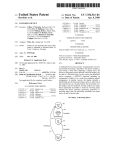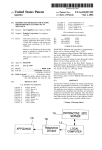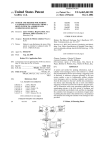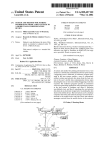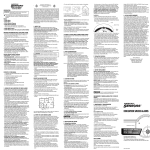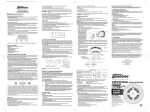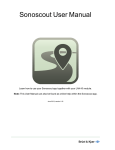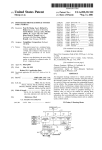Download Computer telephony audio configuration
Transcript
US006731993B1 (12) United States Patent (10) Patent N0.: Carter et al. (45) Date of Patent: (54) COMPUTER TELEPHONY AUDIO CONFIGURATION (75) Inventors: George E. Carter, Santa Clara, CA (73) Assigneez 5,870,465 A 5,896,443 A 5,917,893 A 5,983,068 A US 6,731,993 B1 May 4, 2004 2/1999 Hosbach et a1. 4/1999 Dichter 6/1999 KatZ 11/1999 Tomich et al. (US); Shmue] Shaffer, pale Alto, CA 6,003,097 A * 12/1999 Richman et a1. ............. .. 710/8 (US); William J. Beyda, Cupertino, CA 670097151 A 12/1999 Staples (Us) 6,009,398 A 12/1999 Mueller et 211. Siemens Information & 6,011,851 A 6,067,084 A * Communication Networks, Inc B0Ca 6,492,999 B1 * 12/2002 Fado et a1. ............... .. 345/727 1/2000 Connor et a1. 5/2000 Fado et a1. ............... .. 345/708 Raton, FL (US) * cited by examiner (*) Notice: Subject to any disclaimer, the term of this patent is extended or adjusted under 35 U_S_C_ 154(k)) by () days_ Primary Examiner—l\/lelur Ramakrishnaiah 57 (21) Appl. N0.: 09/527,074 (22) Filed ( ) Mar 16 2000 ' ' ABSTRACT Techniques for validating an audio con?guration of a com ’ puter are provided. Validation tests are performed on the (51) Int. Cl.7 .............................................. .. G06E 17/00 audio con?guration and results from the tests are displayed (52) US. Cl. ........................................ .. 700/94; 345/727 to a user as a report The report can include an indication of (58) Field of Search .............................. .. 700/94; 710/8, 710/9, 11; 713/1; 709/219, 220; 381/56_59, 101_103, 96; 345/727, 728; 379/9001 the audio chh?guratihh Settings that Will adversely affect the audio quality for such uses as computer telephony. Additionally, the report can indicate a recommendation on changing the audio con?guration to improve audio quality (56) References Cited and can assist the user in making the audio con?guration change. U.S. PATENT DOCUMENTS 5,797,028 A 33 Claims, 9 Drawing Sheets 8/1998 Gulick et a1. Validating Audio Con?guration it Retrieve an Audio Configuration Setting of the _/101 Computer V Compare the Audio Configuration Setting to a A 103 Stored Optimal Setting ( 107 Log Non-Optimal Audio Configuration Setting Display a Report That Audio Configuration Setting(s) is Not Optimal it Not Equal to Stored Optimal Setting(s) V ( Done ) U.S. Patent 51 w Processor May 4, 2004 Sheet 1 0f 9 53\ f- 55 Fixed Memory Storage I I 4 I Display Adapter i r3 _ Drsplay US 6,731,993 B1 f 57 Removable Storage Ir , 67 Sound Card rg Keyboard f 11 Mouse FIG. 2 i f 63 Transducers f 65 Network Interface U.S. Patent May 4, 2004 Sheet 2 0f 9 US 6,731,993 B1 Validating Audio Configuration Retrieve an Audio —> Configuration Setting of the _/ 101 Computer l Compare the Audio Configuration Setting to a A 103 Stored Optimal Setting ( 107 Log Non-Optimal Audio Configuration Setting Display a Report That Audio Configuration Setting'(s) is a/ 111 Not Optimal if Not Equal to Stored Optimal Setting(s) FIG. 3 U.S. Patent May 4, 2004 Sheet 3 0f 9 US 6,731,993 B1 Validating Audio Configuration Examine the Computer to Determine Hardware of the Computer l Retrieve an Audio Configuration Setting of the ’\ 203 Computer ( 207 205 No Access Network to Retrieve the Stored Optimal Setting Yes (I 209 Compare the Audio Configuration Setting to a a 1 Stored Optimal Setting (213 A Log Non-optimal Audio Configuration Setting Display a Report That Audio Configuration Setting(s) is Not Optimal if Not Equal to Stored Optimal Setting(s) FIG. 4 U.S. Patent May 4, 2004 Sheet 4 0f 9 US 6,731,993 B1 Validating Audio Configuration Retrieve Multiple Audio —> Configuration Settings of N 251 the Computer Analyze the Audio Configuration Settings V 253 K 257 Log Non-Optimal Audio Configuration Setting Display a Report That Audio Configuration Setting(s) Is Not Optimal if Not Optimal in V 261 Relation to Other Setting(s) @ FIG. 5 U.S. Patent May 4, 2004 307w Sheet 5 0f 9 US 6,731,993 B1 305w ' Web-based Local Database <—-> Program for Updates Database A 303 \~' _ _ Conflg Validate Button 4 <——— ( 319 ( 317 End of Remote Installation Activation Activation (Tech Support) w 301 309 v f 1st Contig Validation Check l K 311 <-— Output Results of 1st Check 5l I l 2 Last Config Validation Check 1, K 315 <——— Output Results of Last Check @ FIG. 6 U.S. Patent May 4, 2004 Sheet 6 of 9 US 6,731,993 B1 Validation Tests Check Microphone Record Control and Line Input A 401 Record Control Selection i Check for No Microphone Record Control and Line input Record Control Selection _/ 403 i Check forAny Other Record A 405 Control Input Selections it Check Mute All Record Control Setting v 407 i Check All Volume Control Settings on the Play Control A 409 + Check All Volume Control Settings on the Selected Record Controls " 411 ‘ Check Balance Controls for V413 Midpoint Settings i Check Play Control Microphone Mute Setting é FIG. 7A "415 U.S. Patent May 4, 2004 Sheet 7 of 9 CiD Check Play Control Wave Mute Setting US 6,731,993 B1 ,\J 431 l Check the Play Control Advanced Area for A 433 Microphone Boost Activation for Windows 95 l Check Play Control Advanced _/\ 435 Area Bass Setting l Check Play Control Advanced Area Treble Setting \’ 437 v Check Unused Inputs on Play Control lr Check Processor Type and Speed x 441 l Check Memory Size v- 443 l Check Video Driver for Overuse of PCI Bus é FIG. 7B A 445 U.S. Patent May 4, 2004 Sheet 8 0f 9 US 6,731,993 B1 @ Check Sound Card Driver N 461 i Check Sound Card Driver for Lower Fidelity A/D (or D/A) ~/- 463 Conversion i Check Registry for Con?icts \ 465 i Check for Full Duplex Operation i Check Software Versions -- 469 i Check the Percentage of Lost RTP (Audio Media) Data Packets ——~ 471 i Check the Variation in RTP Data Packet Inter-arrival Times (or Jitter) @ FIG. 7C w 473 U.S. Patent May 4, 2004 Sheet 9 0f 9 moml 2;@253 52%58 [email protected] 5,.535238%; 1/ . U 2 6 =< E 2 3 o : u I _ w 0 2 o m 5850658:58 8m/ US 6,731,993 B1 mom\\ A/5>552:{5G-:E8m “onI $$322@2=85 ‘5 5@£38582 .wE w US 6,731,993 B1 1 2 COMPUTER TELEPHONY AUDIO CONFIGURATION Companies have attempted to document, such as on a Web page, an application note or in a user manual, the audio con?guration issues for computer telephony clients and suggested solutions. Unfortunately, many, if not most, users do not have the initiative or the time to utiliZe such docu BACKGROUND OF THE INVENTION The present invention relates to audio con?guration for computer systems. More particularly, the invention relates to validating an audio con?guration of a computer for com puter telephony. 1O Conventional telephones operate using circuit-sWitched technology. The circuit-sWitched telephone backbone is composed of dedicated copper Wires or ?ber optic cables that are typically oWned by the telephone companies. In general, the telephone companies charge telephone call fees, mentation. Therefore, this loW cost solution has achieved results that are far from satisfactory. It Would be bene?cial to have innovative techniques for validating an audio con?guration of a computer. Additionally, it Would be bene?cial to have techniques that automatically checked the audio con?guration of a computer telephony system and indicated to the user the settings that should be changed to ?x or improve audio quality. SUMMARY OF THE INVENTION 15 based on the duration of the call and the distance betWeen the caller and receiver, that are designed to cover the costs The present invention provides innovative techniques for validating an audio con?guration of a computer. In general, for installing, expanding and maintaining the telephone one or a series of audio con?guration settings of the com backbone. puter are retrieved and compared to a stored optimal setting or settings. A report can then be generated to a user that With packet-sWitched telephone systems, a speaker’s indicates the audio con?guration settings that should be changed, Which can be speci?cally optimiZed according to the speci?c hardWare of the computer system. In this voice (or other data) is broken doWn and sent over a computer netWork as multiple packets. Computer telephony can offer signi?cant cost savings because dedicated netWork connections are replaced by netWork connections shared manner, users can quickly and ef?ciently verify the audio con?guration of their computers. Some embodiments of the among many users, Which results in much more efficient use 25 invention are described beloW. of bandWidth and reduced Wiring costs. Additionally, in In one embodiment, the invention provides a computer theory, computer telephony can offer easier administration. In the past, the computer and netWork technologies had not advanced to the point Where the quality of computer implemented method of validating an audio con?guration of a computer. An audio con?guration setting of the computer is retrieved. The retrieved audio con?guration setting is compared to a stored optimal setting. If the audio con?gu ration setting is not equal to the stored optimal setting, a report, indicating that the audio con?guration setting of the telephony approached the quality of conventional telephone systems. Therefore, the cost and convenience savings of computer telephony came at a price of loWer quality. However, as computer and netWork technologies continue to improve, the quality differential is diminishing or is non existent, and so computer telephony is becoming more and 35 that can be stored locally on the computer or remotely on a more prevalent. netWork. In another embodiment, the invention provides a com One of the major problems facing computer telephony clients is that they are executing on computers With general puter implemented method of validating an audio con?gu purpose operating systems. These general purpose operating ration of a computer. The computer is examined to deter systems are designed to support a Wide variety of applica tions so there are typically a very large number of audio con?guration settings. Although the numerous audio con ?guration settings alloW the computers to be very ?exible and adaptable to a Wide variety of applications, there is a considerable increase in complexity in audio con?guration. Audio con?guration errors and less-than-optimal con?gu 45 mine hardWare of the computer. An audio con?guration setting of the computer is retrieved. The audio con?guration setting is compared to a stored optimal setting based on the hardWare of the computer. If the audio con?guration setting is not equal to the stored optimal setting, a report, indicating that the audio con?guration setting of the computer is not optimal, is displayed to a user. Typically, the hardWare of the computer is stored in a con?guration database, such as a rations are common, Which often results in a variety of audio quality problems that in turn impede the effectiveness of WINDOWS Registry. In preferred embodiments, the stored optimal setting is one that is optimal for computer telephony computer telephony systems. The conventional solution to complex audio con?guration of computer systems is to rely on information technology experts. The expert can set the audio con?guration in person, applications. In another embodiment, the invention provides a com puter implemented method of validating an audio con?gu ration of a computer. Multiple audio con?guration settings give instructions to a user over the telephone or by e-mail, utiliZe an application sharing session, or the like. The expert can be employed by the company be an independent contractor, or be employed by a computer telephony vendor. computer is not optimal, is displayed to a user. The stored optimal setting can be a speci?c value or a range of values 55 of the computer are retrieved. The audio con?guration settings are analyZed. If the audio con?guration setting is not optimal in relation to one or more of the other audio A major disadvantage of utiliZing information technology con?guration settings, a report, indicating that an audio experts for audio con?guration is the high cost of employing con?guration setting of the computer is not optimal, is the experts, Which Will inevitably be passed on to the displayed to a user. The audio con?guration settings can be companies that are utiliZing the computer telephony sys tems. Additionally, these companies Will be further frus trated by the dif?culty in getting computer telephony to Work calculation or the like. analyZed by computing a Boolean calculation, numerical correctly, as they are used to traditional telephones that Were plugged in and simply Worked. Another solution to audio con?guration complexities that does not have as high a cost is the use of documentation. 65 Other features and advantages of the invention Will become readily apparent upon the revieW of the folloWing description in association With the accompanying draWings. In the draWings, the same or similar structures Will be identi?ed by the same reference numerals. US 6,731,993 B1 3 4 BRIEF DESCRIPTION OF THE DRAWINGS computer systems suitable for use With the invention can include additional or feWer subsystems. For example, FIG. 1 illustrates an example of a computer system that another computer system could include more than one processor 51 (i.e., a multi-processor system) or a cache memory. can be utilized to execute the software of an embodiment of the invention and use hardware embodiments. FIG. 2 illustrates a system block diagram of the computer system of FIG. 1. The system bus architecture of computer system 1 is FIG. 3 shoWs a ?oWchart of a process of validating an audio con?guration of a computer. FIG. 4 shoWs a ?oWchart of a process of validating an 10 audio con?guration of a computer that takes into account the display adapter. Computer system 1 shoWn in FIG. 2 is but speci?c hardWare of the computer. an example of a computer system suitable for use With the FIG. 5 shoWs a ?oWchart of a process of validating an audio con?guration of a computer that analyZes multiple audio con?guration settings in relation to one another. 15 FIG. 6 shoWs a block diagram of an embodiment that alloWs users to have a series of validation checks performed Accordingly, there are typically numerous audio con?gura tion settings that can be adjusted to accommodate speci?c applications, Which can make validating an audio con?gu ration dif?cult. FIGS. 7A—7C shoW a ?oWchart of a series of validation tests that can be performed to validate the audio con?gura tion of a computer telephony system. FIG. 8 shoWs a sample screen display of a report that FIG. 3 shoWs a How chart of a process of validating an audio con?guration of a computer, according to a speci?c indicates to a user audio con?guration settings that are incorrect or not optimal for computer telephony applica invention. Other computer architectures having different con?gurations of subsystems can also be utiliZed. Currently, computer telephony applications are executed on general purpose computers that have operating systems that are designed to run a Wide variety of applications. on the audio con?guration of a computer telephony system. tions. represented by arroWs 67. HoWever, these arroWs are illus trative of any interconnection scheme serving to link the subsystems. For example, a local bus could be utiliZed to connect the central processor to the system memory and/or 25 DETAILED DESCRIPTION OF EMBODIMENTS embodiment of the invention. The process can be initiated any number of Ways, such as by a direct request of a user (e.g., clicking on a WindoW object), upon start up of a computer telephony application, upon completion of install In the description that folloWs, the present invention Will ing a computer telephony application, and by remote access be described in reference to embodiments that validate an by information technology support personnel. At a step 101, audio con?guration of a computer system. More speci?cally, the embodiments Will be described in reference to preferred embodiments that validate the audio con?guration of the Audio con?guration settings are typically stored in a con computer for telephony applications. HoWever, the inven operating systems. Other operating systems have analogous mechanisms for storing con?guration information. tion is not limited to the speci?c applications, architectures an audio con?guration setting of the computer is retrieved. ?guration database, Which is the Registry in WINDOWS 35 The audio con?guration setting is compared to a stored optimal setting at a step 103. The optimal setting can be a or implementations described herein as the invention can be implemented in different Ways. Therefore, the description of speci?c value or can specify a range of values. At a step 105, the embodiment that folloWs is for purposes of illustration and not limitation. FIG. 1 illustrates an example of a computer system that it is determined if the audio con?guration setting is equal to the stored optimal setting. In the case Where the optimal setting is a range of values, it is determined if the audio con?guration setting is Within the speci?ed range. If the settings are determined to not be equal, the non-optimal audio con?guration setting is logged at a step 107. can be used to execute the softWare of an embodiment of the invention and use hardWare embodiments. FIG. 1 shoWs a computer system 1 that includes a display 3, screen 5, cabinet 7, keyboard 9, and mouse 11. Mouse 11 can have one or more buttons for interacting With a graphical user inter 45 face (GUI). Cabinet 7 houses a CD-ROM drive 13, system memory and a hard drive (see FIG. 2) Which can be utiliZed to store and retrieve softWare programs incorporating com OtherWise, it is determined Whether there are more audio con?guration settings to test at a step 109 and the How continues to step 101 if there are more audio con?guration settings to be tested. puter code that implements aspects of the invention, data for At a step 111, a report, indicating that one or more audio use With the invention, and the like. Although CD-ROM 15 is shoWn as an exemplary computer readable storage con?guration settings is not optimal if any Were not equal to the stored optimal setting or settings, is displayed to a user. medium, other computer readable storage media including ?oppy disk, tape, ?ash memory, system memory, and hard Generation of the report typically involves combining the non-optimal audio con?guration settings that Were logged at drive can be utiliZed. Additionally, a data signal embodied in a carrier Wave (e.g., in a netWork including the Internet) can 55 the audio con?guration setting should be changed, the value that the audio con?guration settings should be changed to, be the computer readable storage medium. FIG. 2 shoWs a system block diagram of computer system and additional instructions on hoW the user can implement 1 used to execute a softWare of an embodiment of the invention or use hardWare embodiments. As in FIG. 1, the changes. In cases Where a con?guration setting is Wrong, and there is only one correct reassignment, this correction computer system 1 includes monitor 3 and keyboard 9, and mouse 11. Computer system 1 further includes subsystems can be made automatically and the user is advised. The report has been described as indicating the non-optimal con?guration settings, hoWever, the report can also include the audio con?guration settings that are equal to or Within such as a central processor 51, system memory 53, ?xed storage 55 (e.g., hard drive), removable storage.57 (e.g., CD-ROM drive), display adapter 59, sound card 61, trans ducers 63 (speakers, microphones, and the like), and net Work interface 65. The netWork interface may provide the communication to the computer telephony netWork. Other step 107. The report can indicate to the user the particular audio con?guration settings that are not optimal, the reasons 65 optimal settings. The How chart described in reference to FIG. 3 can be utiliZed to validate an audio con?guration of a computer and, US 6,731,993 B1 5 6 more speci?cally, to validate the con?guration for computer telephony applications. Another complication is that some If there are no more audio con?guration settings to be tested, then at a step 261 a report, indicating that one or more hardware manufacturers (e.g., video card manufacturers) audio con?guration settings is not optimal if any Were not optimal in relation to another audio con?guration setting or design their hardWare so that it is better suited for some speci?c applications. Therefore, in some embodiments, the optimal settings can be adjusted or set according to the speci?c hardWare that is settings, is displayed to a user. As before, the report can indicate to the user the particular audio con?guration set tings that are not optimal, the reasons the audio con?gura in the computer. FIG. 4 shoWs a ?oWchart of a process of tion setting should be changed, the value that the audio validating an audio con?guration of a computer that takes into account the hardWare of the computer. As seen in FIG. 4, at a step 201, the computer is eXamined to determine hardWare of the computer. At a step 203, an audio con?gu con?guration settings should be changed to, and additional 10 FIGS. 3, 4 and 5 have described different types of analysis that can be utiliZed to test audio con?guration settings. Although the How charts have been described as different embodiments for ease of illustration, embodiments of the ration setting of the computer is retrieved. Typically, the identi?cation of hardWare installed on the computer, such as audio and video cards, is speci?ed in a con?guration data base. In the neWest version of the WINDOWS operating instructions on hoW the user can implement the changes. 15 invention can include the tests of one or more of the How charts. FIG. 6 shoWs a block diagram of one embodiment of the systems, the con?guration database is the Registry. Software can eXamine the contents of the con?guration database to invention. A telephony client graphical user interface (GUI) determine the hardWare of the computer. Other operating systems have similar mechanisms (including con?guration 301 can be shoWn in screen 5 of computer system 1 (shoWn in FIG. 1). GUI 301 is shoWn to include a con?guration ?les) that store this information. validation button 303. When the user clicks on or otherWise activates button 303, softWare is eXecuted to validate the audio con?guration of the system and can include steps that It is then determined at a step 205 Whether an optimal setting for the hardWare of the computer is stored locally. If so, the system proceeds to step 209. HoWever, if the stored optimal setting is not found locally, a netWork, such as a are described herein. 25 In validating the audio con?guration, a local program local area netWork or the Internet is accessed to retrieve the database 305 can be accessed in order to determine stored stored optimal setting at a step 207. For eXample, hardWare manufacturers can store optimal settings for their hardWare optimal settings for the audio con?guration. Additionally, a on their Web site. It should be noted that not all of the identify other optimal settings. For eXample, Web-based netWork such as Web-based database 307 can be accessed to con?guration settings may be dependent upon the hardWare database 307 can store optimal settings for speci?c hard of the computer and these con?guration settings can be Ware. Once stored optimal settings are retrieved from a handled as described in reference to FIG. 3. remote netWork, the optimal settings can be stored locally on the computer for subsequent use. At a step 209, the audio con?guration setting is compared to the stored optimal setting. As described above, the opti 35 As shoWn, FIG. 6 illustrates that a series of audio con be equal to the stored optimal setting, then the non-optimal ?guration validation checks can be performed With the output results being displayed on GUI 301. A ?rst con?gu ration validation check 309 is performed and output results audio con?guration setting is logged at a step 213. If it is 311 of the ?rst check are displayed to the user. Although a mal setting can be a speci?c value or a range of values. If the audio con?guration setting is determined at a step 211 not to determined at a step 215 that there are more audio con?gu single validation check can be performed, typical embodi ration settings to test, the system continues to step 203 to test ments include a series of validation checks that end With a the additional audio con?guration settings. last con?guration validation check 313 and output results If there are no more audio con?guration settings to test, then at a step 217 a report, indicating that an audio con?gu 315 of the last check that are displayed in GUI 301. The output results can be combined into a single report for the ration setting (or settings) is not optimal if the audio con ?guration setting is not equal to the stored optimal setting, is displayed. An eXample of a report that can be displayed is 45 As further shoWn in FIG. 6, remote activation 317 of audio validation checks can be initiated by technical support personnel, and activation 319 of audio validation checks at shoWn in FIG. 8 and Will be described later in more detail in reference to that ?gure. the end of installation also can be initiated. In order to shoW one embodiment of the invention, the linear series of audio validation checks can be performed on FIG. 5 shoWs a ?oWchart of a process of validating an audio con?guration of a computer that analyZes multiple a computer telephony system utiliZing the WINDOWS (95, 98, and NT) operating system With a Widely deployed sound audio con?guration settings in relation to one another. At a step 251, multiple audio con?guration settings of the com puter are retrieved. The audio con?guration settings then are analyZed at a step 253. The analysis can include Boolean, user to vieW. 55 card and driver installed, the SoundBlaster 16/AWE line. Analogous checks can be made on other computer telephony numerical or other calculations in order to determine if an systems. For eXample, other less popular sound cards and audio con?guration setting (or settings) is optimal or appro drivers may require many of the same tests, but there can be some variations based on the capability of the card, the driver and the associated sound card softWare. At a test 401 of FIG. 7A, the Microphone Record Control priate in relation to the other audio con?guration setting or settings. If, at a step 255, it is determined that an audio con?gu ration setting is not optimal in relation to the other audio con?guration settings, then the non-optimal audio con?gu ration setting is logged at a step 257. OtherWise, it is determined Whether there are more audio con?guration settings to test at a step 259. The system continues to step 65 251 if there are more audio con?guration settings to be tested. and Line Input Record Control selection is checked. If the Microphone Record Control is not selected and the Line Input Record Control is selected, a message, sent to verify that a user’s microphone is designed to be connected to the Line In port of the sound card as has been speci?ed, can be displayed to the user. This message is generated because this is the correct audio con?guration in only a small minority of US 6,731,993 B1 7 8 cases. Additionally, a message can be issued that tells the The Play Control Microphone Mute setting is checked at a test 415. If the Play Control Microphone Mute setting is user to verify that if this is the correct con?guration, he should verify that the physical connection of the microphone not selected, a message can be displayed advising the user that the output of the speakers Will contain a mix of audio from the far end and his oWn ampli?ed voice. This sidetone signal is far too loud With the SoundBlaster driver and is to the Line In port of the sound card. Further, a message can be displayed that indicates: if the user’s microphone is designed to be connected to the Microphone Input, then the user needs to insure that the microphone is connected to the Microphone Input port on the sound card and to recon?gure the Microphone Record Control to be selected instead of the Line Input Record Control. A check is made at a test 403 for no Microphone Record cannot be appropriately adjusted With this driver. Thus, this mute setting should be selected (Which turns off the 10 Control and Line Input Record Control selection. If neither the Microphone Record Control nor the Line Input Record Control is selected, a message can be displayed to the user that an error has been found With this part of the audio con?guration. Computer telephony microphones almost sidetone) on this sound card and driver combination. Referring noW to FIG. 7B, the Play Control Wave Mute setting is checked in test 431. If the Play Control Wave Mute setting is selected, a message is displayed advising the user that this setting turns off the playing of computer telephony audio through his output device and is almost alWays an 15 alWays connect to one of these inputs, usually the Micro phone Input port. If neither is selected, there is likely an error and the user can be informed that one of these selections should be made. error in the audio con?guration for this system. At a test 433, the Play Control Advanced area for Micro phone Boost activation is checked on WINDOWS 95 only. If the Microphone Boost activation is selected, the user is advised that background noise and/or echo are likely to be At a test 405, a check is made for any other Record at unacceptably high levels. Microphone Boost activation Control input selections. If there are other Record Control inputs selected, the user can be informed that these other inputs should be deselected to eliminate one potential source permits the use of microphones that are not Well matched to of noise, unless, for example, the user Wishes to play CD audio or a MIDI ?le as part of a computer telephony call. The Mute All Record Control setting is checked at a test the sound card being used. HoWever, Microphone Boost activation accomplishes this result through excessive, inher ently high noise ampli?cation. The user Will be advised if 25 407. If the Mute All Record Control is selected, a message can be displayed to the user that this is an error that Will prevent sending any audio from this computer telephony reduced to compensate. In this case, the user is advised to system to the netWork. At a test 409, all the volume control settings on the Play simply deselect the Microphone Boost activation setting and increase the Record Control microphone volume setting, Which Will reduce background noise levels being transmit Control are checked. A message can be output for any volume control that is set above 70% of maximum advising the user that driving ampli?ers in this top range can lead to clipping. Also, the user can be advised to reduce the volume 35 control to 70% and then to increase the volume on the a message is output that such a bass enhancement is asso ciated With loWer levels of vocal clarity and that reducing this setting can increase vocal clarity. Similarly, the Play Control Advanced area Treble setting can be checked at a audio quality. All the volume control settings on the selected Record Controls are checked at a test 411. If any volume control 45 setting is above 70% of maximum, the user can be advised that driving such preampli?ers in this top range can lead to clipping. If the user has to set the volume control setting to above 70% in order to get adequate volume at the far end, the user can be advised to investigate Whether the micro test 437. If this setting is in the loWer 33% of the range, a message can be output that such treble minimiZation is associated With loWer levels of vocal clarity and that increas ing this setting can increase vocal clarity. The unused inputs on Play Control are checked at a test 439. Amessage can be displayed informing users that if they notice persistent background noise is being transmitted, they should try to mute the unused input in this control. For some phone is plugged into the correct input port, Whether the microphone’s output voltage is sufficient, and Whether the microphone’s impedance is matched to the speci?cations of microphone ampli?er. error if one Wishes to have high sound quality, and the user at a test 435. If this setting is in the upper 33% of the range, can also be informed that if the volume on the external speakers are set to over 70% of maximum, a higher poWer ampli?er may be needed so that a loWer volume setting on the external speakers can be used in order to receive better using a different microphone With speci?cations better matching the sound card or by inserting an intervening ted. In summary, selecting this setting is almost alWays an Will be advised of the speci?cs of this setting. The Play Control Advanced area Bass setting is checked external speakers until the desired level is reached. The user the sound card. If not, a message can be displayed advising the user that better sound quality can be obtained by either this item is selected that it is much better to have a microphone that both matches the sound card being used and has this setting turned off. Another possibility is that the microphone is matched correctly but this setting Was selected by mistake and the microphone record volume Was sound cards, this Will reduce background noise levels. Users that are not experiencing background noise problems can ignore this message. 55 At a test 441, the processor type and speed are checked. If the processor type and speed are beloW a recommended minimum, a message, reminding the user that audio quality At a test 413, the balance controls are checked for and other problems may occur When running this computer telephony client on under poWered systems, can be output. midpoint settings. If non-midpoint settings are found, a In a similar manner, the memory siZe is checked at a test message Will advise the user that non-midpoint settings of this control can cause one speaker to be driven at a higher 443. If the memory siZe is beloW a recommended minimum, the message reminding the user that audio quality and other volume than the other, causing the audio to sound different problems may occur When running this computer telephony client on under poWered systems. than most people are expecting. In one embodiment, non At a test 445 the video driver is checked for overuse of the midpoint settings are de?ned as being more than 5% from 65 PCI bus. Some video drivers are knoWn for their overly the nominal midpoint value. Thus, the midpoint range aggressive use of the PCI bus. A list of these video drivers occupies the central 10% of the balance range. US 6,731,993 B1 9 10 is consulted and if a match is obtained, a message is displayed to advise that the use of the installed video driver can result in audio quality problems. If a video driver known age or value is read from the RTP softWare module and is not included in the WINDOWS Registry. If this value is more than a speci?c amount (e.g., 2%), a message indicating the to be more compatible With high audio quality exists for the card and the operating system being used, a message can be displayed specifying the exact name of that driver and Where percentage of RTP data packets being lost is displayed along it can be obtained. In some embodiments, the better driver processor upgrade or con?guration changes are likely can be automatically located and doWnloaded (e.g., from the needed to reduce this percentage. In one embodiment, the percentage is a variable that can be changed over time With an initial value of 2%. With a notation that this can impact audio quality. Additionally, the user can be informed that a netWork and/or Internet). At a test 461 in FIG. 7C, the sound card driver is checked to determine if it creates knoWn audio quality problems or if 10 The variation in RTP data packet inter-arrival times (also it adversely impacts system reliability. There are knoWn knoWn as jitter) is checked at a test 473. The variation in sound card drivers that cause audio quality problems or RTP data packet inter-arrival times is determined since the last of either system startup or the last audio con?guration validation. The variation is read from the RTP softWare module and is not included in the WINDOWS Registry. On adversely impact system reliability and the installed sound card driver is compared to a list of such drivers. If the sound card driver is on the list, a message is displayed informing 15 the user that the current sound card driver may cause audio a system Without a jitter buffer, if the variation exceeds a quality problems or adversely impact system reliability. The predetermined amount, a message is output noting that jitter has reached the read variation and is impacting audio sound card driver can be checked to determine Whether it is equal to or neWer than the recommended earliest acceptable quality. In one embodiment the predetermined value is a version. If the sound card driver is older than recommended, variable that can be changed over time With an initial value the user can be informed that sound quality can be increased of 50 milliseconds. On systems With a jitter buffer, if the read or system reliability improved by installing a supported variation exceeds a predetermined value, a message notes neWer version. that jitter has reached the read variation, Which is impacting The sound card driver can also be checked to determine 25 audio quality because delays of this magnitude constitute a if it uses loWer ?delity analog-to-digital (or digital-to problem in itself, apart from problems created by the varia analog) conversion for one of the tWo paths open for a full tion. In one embodiment, the predetermined value is a variable set to initially 400 milliseconds. duplex connection at a test 463. There can be stored a list of sound card drivers that use loWer ?delity conversion, and the NoW that a series of validation tests in one embodiment current sound card driver can be checked if it is on that list. have been described in detail, it may be bene?cial to shoW Some very popular sound cards support 16-bit A/D conver an example of a report that can be displayed to a user. FIG. 8 shoWs a screen display including a WindoW 501 that includes a report of the result from the validation tests as described in reference to FIGS. 7A—7C. A WindoW 501 sion for the ?rst path opened but only 8-bit A/D conversion for the other path of a full duplex link. The user can be advised that if one direction of the communication from their computer telephony client is alWays loW quality regard 35 indicates that after performing the automated audio con?gu less of the end point, the loWer ?delity conversion can be the ration validation, some audio con?guration settings Were cause. The user can be advised that the best solution is the replacement of the sound card With one that supports 16-bit determined to be incorrect or not optimal. A result 503 indicates that the Mute All Record Control is selected and or better A/D in both directions. At a test 465, the Registry can be checked to see if the includes a recommendation to the user to de-select the Mute current audio con?guration settings of the sound card are causing any con?icts. If the settings are causing a con?ict, a message can be displayed informing the user exactly What resource (IRQ, port address or DMA) is con?icting and that the user should resolve his con?ict in the Control Panel. Some miscon?gurations in this area result in poor sound quality, and many miscon?gurations can prevent the audio from Working at all. Full duplex operation is checked at a test 467. Full duplex that this Will prevent sending audio. Additionally, result 503 All Record Control setting. In this embodiment, if the user is unsure hoW to make the recommended change to the audio con?guration, a help button 505 can be activated and the user Will be shoWn hoW to make the recommended audio 45 con?guration change. Result 503 can be generated from validation test 407 in FIG. 7A. In FIG. 8, a result 507 indicates that the Play Control setting is greater than 70% and that a setting above 70% clipping may be evident. Additionally, result 507 recom operation is checked by opening the sound card for both mends to the user to loWer the Play Control to 70%. As input and output. If either the hardWare or softWare driver do not permit this operation, a message notes the lack of full duplex support and advises the user that the installation of either an appropriate full duplex driver or a full duplex card and driver combination is required. The open connections to the sound card for both input and output should also be closed before the validation tests continue. before, a help button 509 may be activated by the user in order to receive more detained inspections on changing the audio con?guration as recommended. Result 507 may be generated from validation test 409 in FIG. 7A. In the report shoWn in FIG. 8, only the validation tests that recommended an audio con?guration change Were shoWn. In other embodiments, the report can include results from all the validation tests Whether an audio con?gure change is 55 At a test 469, the softWare versions are checked for all installed softWare. A message is displayed indicating any recommended or not. It should be evident that the informa softWare that is older than the oldest supported release or any softWare that is knoWn to be incompatible With any other installed softWare. tion and layout of the report can be varied greatly and the invention is not limited by the embodiment described herein. While the above is complete description of an exemplary embodiment of the invention, various alternatives, modi? cations and equivalents can be used. It should be evident that At a test 471, the percentage of lost RTP (audio media) data packets is checked. The percentage of RTP data packets 65 that Were lost since the last of either system startup or the last the invention is equally applicable by making appropriate audio con?guration validation is determined. This percent modi?cations to the embodiments described above. For US 6,731,993 B1 11 12 18. The method of claim 17, Wherein the stored optimal example, the techniques described above Were utilized to optimize an audio con?guration for computer telephony but the invention can also be advantageously applied to opti setting is optimal for computer telephony applications. miZing or validating audio con?gurations or other uses. Therefore, the above description should not be taken as con?guration of a computer, comprising: 19. A computer program product that validates an audio computer code that retrieves an audio con?guration set limiting the scope of the invention that is de?ned by the metes and bounds of the folloWing claims along With their full scope of equivalents. What is claimed: 1. Acomputer implemented method of validating an audio con?guration of a computer, comprising: retrieving an audio con?guration setting of the computer; comparing the audio con?guration setting to a stored ting of the computer; computer code that compares the audio con?guration setting to a stored optimal setting; computer code that displays a report to a user that the audio con?guration setting of the computer is not optimal if the audio con?guration setting is not equal to the stored optimal setting; and optimal setting; and displaying a report to a user that the audio con?guration a computer readable medium that stores the computer codes. setting of the computer is not optimal if the audio con?guration setting is not equal to the stored optimal 20. The computer program product of claim 19, Wherein the computer readable medium is a CD-ROM, ?oppy disk, setting. tape, ?ash memory, system memory, hard drive, or a data signal embodied in a carrier Wave. 2. The method of claim 1, Wherein the stored optimal setting is a speci?c value or a range of values. 21. The computer program product of claim 19 further 3. The method of claim 1, Wherein the stored optimal setting is stored locally on the computer. 4. The method of claim 1, Wherein the stored optimal comprising: setting is stored remotely on a netWork. 5. The method of claim 1, Wherein the audio con?guration relates to hardWare of the computer. 25 computer code that eXamines the computer to determine hardWare of the computer; and Wherein said stored optimal setting is further based on the hardWare of the computer. 22. A system, comprising: 6. The method of claim 5, further comprising retrieving the stored optimal setting for the hardWare from a database that stores optimal settings for different hardWare. 7. The method of claim 1, further comprising: a processor; and a computer readable medium storing a computer program including computer code that retrieves an audio con retrieving a plurality of audio con?guration settings of the ?guration setting of the computer, computer code that computer; analyZing the plurality of audio con?guration settings; optimal setting, and computer code that displays a and displaying in the report to the user that an audio con?gu compares the audio con?guration setting to a stored report to a user that the audio con?guration setting of con?guration setting is not optimal in relation to one or more of the other audio con?guration settings. the computer is not optimal if the audio con?guration setting is not equal to the stored optimal setting. 23. The system of claim 22, Wherein the computer read able medium is a CD-ROM, ?oppy disk, tape, ?ash memory, 8. The method of claim 7, Wherein analyZing further system memory, hard drive, or a data signal embodied in a 35 ration setting of the computer is not optimal if the audio includes computing a Boolean or numerical calculation on carrier Wave. the plurality of audio con?guration settings. 24. The system of claim 22, Wherein said computer program also includes computer code that eXamines the computer to determine hardWare of the computer, and Wherein said stored optimal setting is further based on the hardWare of the computer. 25. A computer implemented method of validating an 9. The method of claim 7, Wherein the report also includes the one or more of the other audio con?guration settings. 10. The method of claim 1, Wherein the report also includes the stored optimal setting. 45 11. The method of claim 1, Wherein the report also includes information on changing the audio con?guration. 12. The method of claim 1, Wherein the audio con?gu audio con?guration of a computer, comprising: retrieving a plurality of audio con?guration settings of the computer; analyZing the plurality of audio con?guration settings; ration is one of a plurality of audio con?gurations that are validated. 13. The method of claim 1, Wherein the stored optimal and setting is optimal for computer telephony applications. 14. The method of claim 5, further comprising: examining the computer to determine hardWare of the computer; and Wherein said stored optimal setting is also based on the hardWare of the computer, and said hardWare of the computer is stored in a con?guration database. 15. The method of claim 14, Wherein the con?guration displaying a report to a user that an audio con?guration setting of the computer is not optimal if the audio 55 con?guration setting is not optimal in relation to one or more of the other audio con?guration settings. 26. The method of claim 25, Wherein analyZing further includes computing a Boolean or numerical calculation on the plurality of audio con?guration settings. 27. The method of claim 25, Wherein the report also database is a WINDOWS Registry. includes the one or more of the other audio con?guration 16. The method of claim 14, Wherein the stored optimal setting is stored in a database that stores optimal settings for different hardWare. settings. 28. The method of claim 25, Wherein the report also includes information on changing the audio con?guration. 29. The method of claim 25, Wherein the audio con?gu 17. The method of claim 16, further comprising accessing a netWork to retrieve the stored optimal setting for the hardWare if the stored optimal setting is not in the database that stores optimal settings for different hardWare. 65 ration setting optimal in relation to the one or more of the other audio con?guration settings for computer telephony applications. US 6,731,993 B1 14 13 32. A system, comprising: 30. A computer program product that validates an audio con?guration of a computer, comprising: computer code that retrieves a plurality of audio con?gu ration settings of the computer; computer code that analyZes the plurality of audio con a processor; and a computer readable medium storing a computer program including computer code that retrieves a plurality of audio con?guration settings of the computer, computer code that analyZes the plurality of audio con?guration ?guration settings; computer code that displays a report to a user that an audio con?guration setting of the computer is not optimal if the audio con?guration setting is not optimal in relation to one or more of the other audio con?gu settings, and computer code that displays a report to a user that an audio con?guration setting of the computer 10 optimal in relation to one or more of the other audio ration settings; and con?guration settings. 33. The system of claim 32, Wherein the computer read able medium is a CD-ROM, ?oppy disk, tape, ?ash memory, a computer readable medium that stores the computer codes. 31. The computer program product of claim 30, Wherein the computer readable medium is a CD-ROM, ?oppy disk, tape, ?ash memory, system memory, hard drive, or a data signal embodied in a carrier wave. is not optimal if the audio con?guration setting is not 15 system memory, hard drive, or a data signal embodied in a carrier Wave.

















